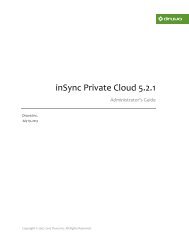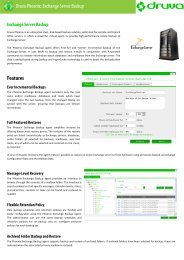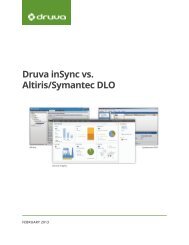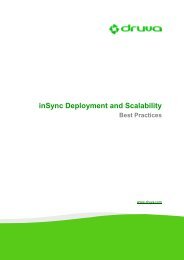inSync Private Cloud 5.2 - inSync Help - Druva
inSync Private Cloud 5.2 - inSync Help - Druva
inSync Private Cloud 5.2 - inSync Help - Druva
Create successful ePaper yourself
Turn your PDF publications into a flip-book with our unique Google optimized e-Paper software.
<strong>inSync</strong> <strong>5.2</strong> <strong>Private</strong> <strong>Cloud</strong> – Administrator’s Guide<br />
Configuring <strong>inSync</strong> <strong>Private</strong> <strong>Cloud</strong><br />
Primary Configuration Activities<br />
Primary configuration activities include those configuration tasks that enables users of your<br />
organization to start backing up and sharing data using <strong>inSync</strong>. Follow the steps in the sequence they<br />
are listed in the table.<br />
Step Activity Description<br />
1 Configure network for<br />
<strong>inSync</strong><br />
By configuring the network you define the IP address<br />
and the port numbers required to access the <strong>inSync</strong><br />
Server.<br />
For instructions, see Configuring Network for <strong>inSync</strong>.<br />
2 Configure email for<br />
<strong>inSync</strong> Server<br />
Various <strong>inSync</strong> activities require <strong>inSync</strong> Server to send<br />
emails to <strong>inSync</strong> users and administrators. For example,<br />
when a new user is added to <strong>inSync</strong>, the user receives<br />
the account information through email.<br />
For instructions, see Configuring Email for <strong>inSync</strong>.<br />
3 Create storage nodes Storage nodes are the servers that performs<br />
backups or restores. They also contain the<br />
storages where data backed up from user devices<br />
are stored.<br />
For instructions, see Creating a Storage Node.<br />
4 Create storages Storages are needed to archive the data backed up<br />
or shared from user's devices.<br />
For instructions, see Creating a Storage.<br />
5 Create profiles In <strong>inSync</strong>, profiles are containers of configurations<br />
that are applicable to a group of users. Through a<br />
profile you can define the files and folders that will<br />
be backed up for users, the backup interval,<br />
resource utilization, and so on.<br />
For instructions, see Creating a Profile.<br />
19









